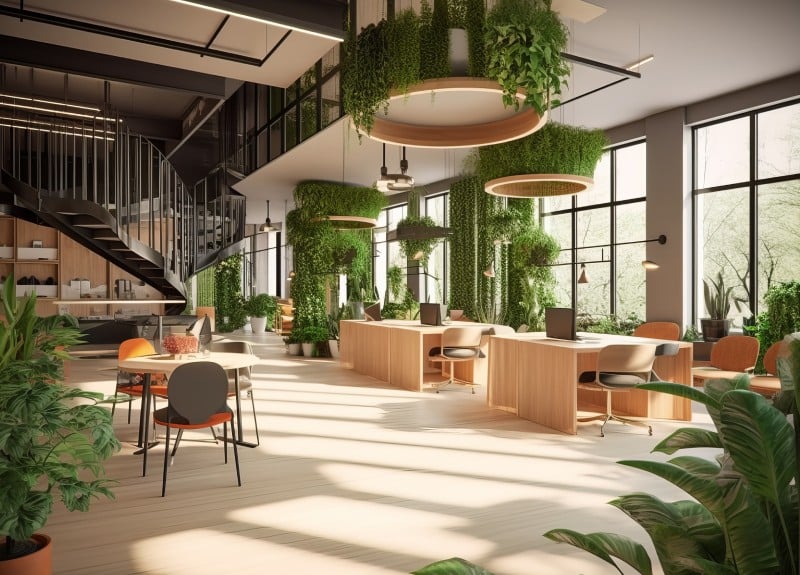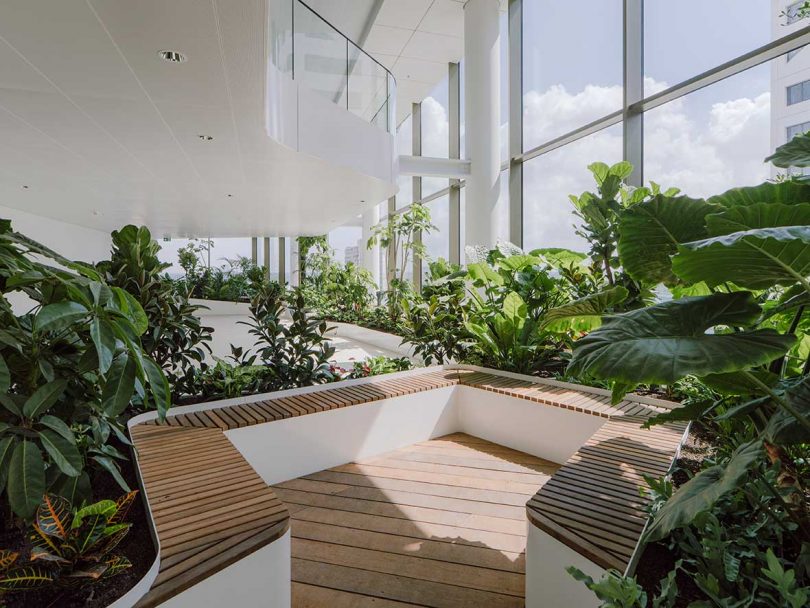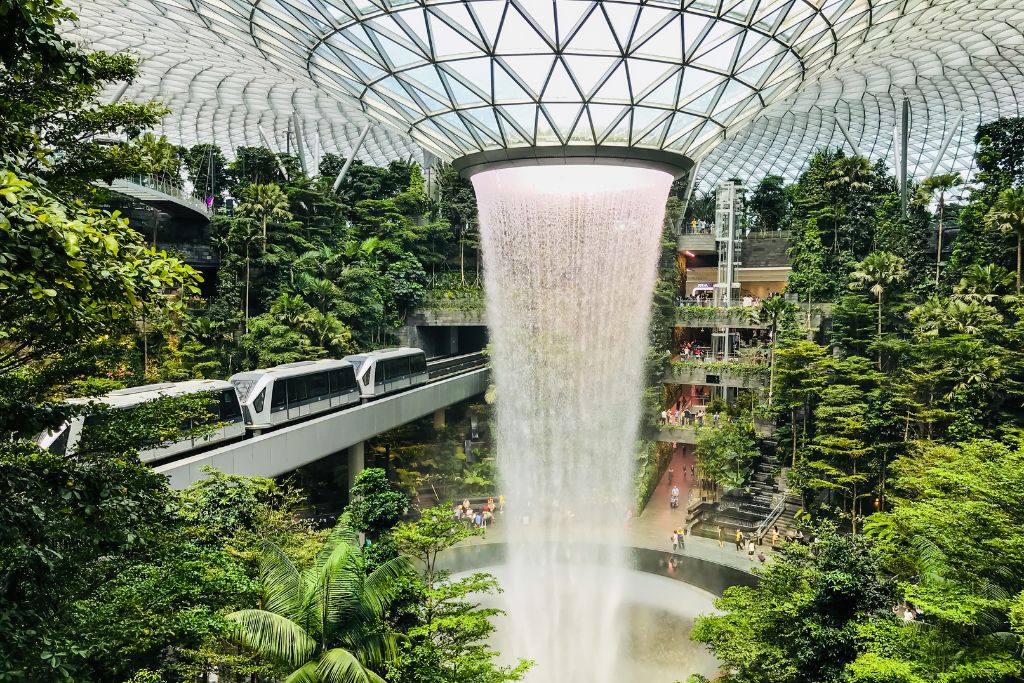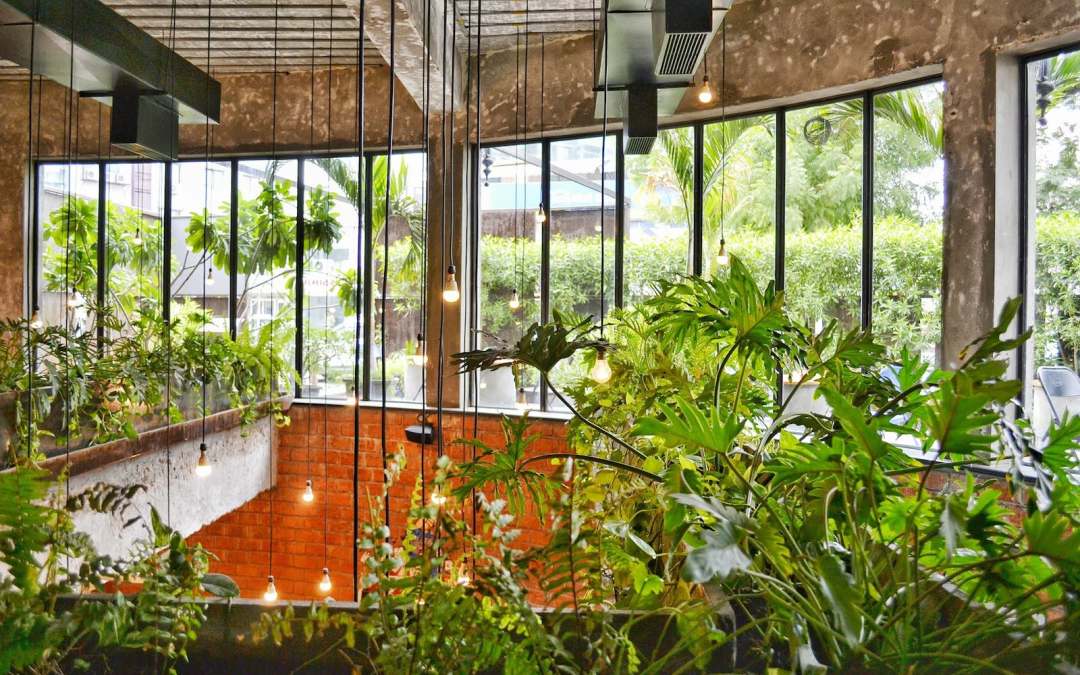Biophilic Design as a Tool for Enhancing Workplace Productivity.
In today’s fast-paced work environment, fostering employee well-being and productivity is of paramount importance.
Biophilic design refers to the integration of natural elements within the workplace environment, crafting spaces that resonate with our intrinsic connection to nature and enhance workplace productivity through nature integration.
This approach underscores the significance of biophilic design, outlining its benefits and illustrating how it can transform the workplace into a nurturing environment that enhances productivity, reduces stress levels, and improves overall employee well-being and health.
It is essential to understand how to incorporate natural light, greenery, and other biophilic elements to establish a thriving workspace that supports employee engagement and cognitive function.
What is Biophilic Design?
.jpg_00.jpeg)
Biophilic design represents a progressive approach in architecture and interior design that aims to seamlessly integrate nature within the built environment, thereby fostering a connection between individuals and the natural world and promoting psychological benefits and emotional connection.
This design philosophy underscores the significance of incorporating natural elements—such as indoor plants, natural light, and organic materials—in order to create restorative environments that enhance employee well-being, workplace satisfaction, and productivity.
By adhering to principles of environmental psychology and nature-inspired architecture, biophilic design aspires to facilitate a healthier and more sustainable workspace, promoting cognitive performance, stress reduction, and enhancing creativity through mindful design practices.
Why is Biophilic Design Important for the Workplace?
Biophilic design is increasingly acknowledged as a crucial factor in enhancing workplace productivity and promoting employee well-being, as it establishes environments that align with human needs, circadian rhythms, and natural rhythms.
By incorporating natural elements such as outdoor spaces, natural ventilation, and biophilic patterns into workplace layouts, organizations can improve employee engagement, foster teamwork in collaborative spaces, and support a culture of sustainability and ecological balance.
Moreover, the focus on natural values encourages a healthier work-life balance, which is essential for employee retention, sustainability, and satisfaction in contemporary work environments.
What are the Benefits of Biophilic Design in the Workplace?
The advantages of biophilic design in the workplace extend well beyond mere aesthetics, significantly influencing employee well-being, stress reduction, cognitive performance, and workplace satisfaction. By integrating biophilic elements such as natural light, indoor plants, and restorative environments, organizations can enhance creativity, improve focus and concentration, promote psychological safety, and encourage community interaction among team members.
These design principles yield substantial health benefits and emotional connection, ultimately fostering a diverse and inclusive workplace culture that values individual experiences and enhances overall productivity metrics.
Research supports the assertion that workplaces infused with biophilic design elements and sustainable materials can lead to reduced absenteeism and turnover rates, thereby creating an environment conducive to performance improvement. For example, studies indicate that access to nature can lower stress hormone levels and elevate mood, resulting in a workforce that is more engaged and motivated.
Incorporating features such as green walls, water elements, and ergonomic furniture can stimulate collaboration and innovation, effectively addressing common workplace challenges such as burnout and disengagement. Ultimately, organizations that embrace biophilic principles can cultivate a holistic approach that nurtures employee satisfaction, promotes workplace satisfaction, and drives overall success.
How Does Biophilic Design Enhance Workplace Productivity?
Biophilic design significantly enhances workplace productivity by establishing environments that stimulate cognitive performance and promote employee engagement through the integration of natural elements and nature connectivity.
By thoughtfully incorporating features such as natural light, visual connections to nature and outdoor spaces, and biophilic patterns, organizations can create immersive workspaces that reduce stress, enhance focus, and promote efficiency, thereby improving productivity metrics.
Moreover, design strategies that prioritize ergonomic considerations, spatial organization, and spatial quality enable employees to excel in their work environments, ultimately strengthening team dynamics, design for health, and facilitating collaboration.
What are the Psychological Effects of Biophilic Design on Employees?
The psychological effects of biophilic design on employees are significant, as exposure to nature and biophilic elements directly influences mood enhancement, cognitive function, and overall well-being. Research indicates that integrating natural light, indoor plants, and outdoor views into workspace aesthetics not only reduces stress levels but also promotes mindfulness in design, fostering a positive work culture and cultivating a more positive work environment.
This connection to nature is essential in enhancing focus, concentration, and nature exposure, which ultimately affects employee satisfaction and engagement.
Numerous studies have demonstrated these benefits in practical applications. For example, a study conducted by the University of Exeter found that workplaces featuring greenery and natural elements experienced a remarkable 15% increase in employee creativity and motivation.
The incorporation of biophilic design in office spaces has also been associated with improved cognitive performance and job performance, enabling employees to address complex tasks more effectively. Furthermore, the calming influence of these natural elements contributes to a significant reduction in physiological stress responses and promotes psychological benefits, thereby enhancing the overall employee experience.
By creating environments that reflect the tranquility of nature, employers can foster a culture that prioritizes mental health, productivity enhancement, and productivity.
How Does Biophilic Design Improve Air Quality and Reduce Sick Leave?
.jpg_01.jpeg)
Biophilic design plays a crucial role in enhancing air quality by integrating natural elements, such as indoor plants, natural ventilation, and sustainable materials, which can lead to a reduction in sick leave among employees. These biophilic components not only elevate the aesthetic appeal of the workspace but also contribute to the creation of a healthier indoor environment and indoor environment quality by filtering pollutants and increasing humidity levels, both of which are vital for employee health.
By prioritizing environmental sustainability and adaptive reuse, organizations can implement long-term wellness programs that promote overall employee satisfaction and productivity.
Research indicates that workplaces designed according to biophilic principles can reduce absenteeism by as much as 15%, as employees experience fewer respiratory issues, mental fatigue, and stress-related health issues. Furthermore, a report by the World Green Building Council highlights that improvements in indoor air quality and the incorporation of acoustics and noise reduction strategies can result in a 6% increase in productivity.
These statistics reinforce the significant correlation between sustainable design practices, nature-inspired architecture, and enhancements in overall employee well-being. Ultimately, cultivating environments enriched with natural elements not only improves the physical workspace but also fosters a thriving atmosphere and positive work culture in which employees can excel.
What are the Effects of Biophilic Design on Employee Stress Levels?
The effects of biophilic design on employee stress levels are significantly beneficial, as it cultivates restorative environments that promote relaxation, tranquility, and social interaction. By incorporating natural experiences, such as views of natural landscapes, nature sounds, and the integration of green elements, organizations can effectively reduce stress and create a serene workplace atmosphere.
This approach not only supports employee well-being but also enhances cognitive performance, productivity, and motivation, ultimately leading to improved organizational outcomes.
For example, organizations that incorporate living walls, maximize natural light, and include indoor plants in their office designs have reported a notable decrease in stress-related health issues and improved thermal comfort among their staff, resulting in higher levels of engagement and job satisfaction.
A prominent illustration of this can be observed in technology companies that design open layouts enriched with natural light and greenery, which has been associated with enhanced focus, collaborative creativity, and flexibility.
As employees spend their working hours in these biophilic environments, they experience a reconnection with nature that rejuvenates their mental clarity, promotes physical activity, and fosters an overall sense of well-being, thereby positively influencing their performance.
What Elements Should Be Incorporated in Biophilic Design for the Workplace?
Incorporating specific biophilic elements into workspace design is essential for creating environments that promote employee well-being, independence, and enhance productivity.
Key components include the maximization of natural light, the integration of indoor plants, and the use of organic and natural materials that reflect natural patterns, all of which contribute to a harmonious aesthetic within the workspace.
Furthermore, the implementation of flexible workspaces that accommodate various spatial arrangements and zoning can further foster creativity and collaboration among team members, thereby aligning with the principles of human-centered design and spatial equity.
How Can Natural Light and Views of Nature Be Incorporated in the Workplace?
Incorporating natural light and views of nature into the workplace can significantly enhance the overall work environment by improving visual comfort, sensory experiences, and fostering a connection to the outdoors. Effective design strategies may involve the strategic placement of windows, the use of skylights, and the creation of open office layouts that facilitate unobstructed sightlines to outdoor areas, enhancing visual stimuli and personal space. These elements not only promote employee well-being but also contribute to increased productivity, creativity, and positive work culture by establishing a natural rhythm within the workspace.
To further augment these benefits, organizations may consider implementing biophilic design principles, which effectively integrate natural elements into the workplace. For instance, Google’s headquarters features extensive glass walls that maximize daylight exposure and offer panoramic views of the surrounding greenery. Research indicates that exposure to natural elements reduces stress, enhances focus, and improves cognitive function, thereby making these design choices valuable investments in employee well-being.
Additionally, incorporating greenery through the use of indoor plants and green walls can further support employee engagement, ultimately fostering a more dynamic and collaborative work environment that enhances workplace satisfaction and productivity.
What Role Do Plants Play in Biophilic Design?
Indoor plants play a pivotal role in biophilic design by facilitating the integration of nature within the workplace, thereby contributing to enhanced health benefits and improved employee morale. These living components not only promote biodiversity in the workspace but also provide sensory experiences that foster relaxation, creativity, and a visual connection to nature.
Research has demonstrated that the incorporation of plants can enhance air quality, reduce stress levels, and improve overall employee satisfaction, making them essential elements of effective workplace design.
The presence of indoor greenery has the potential to transform a sterile environment into a vibrant ecosystem, fostering a sense of connection to nature. This interaction not only promotes visual comfort but also aids in enhancing focus and boosting productivity.
Proximity to plants has been associated with lower incidences of fatigue and illness, underscoring their significance in enhancing overall well-being. By enriching sensory experiences through a variety of textures, colors, and scents, indoor plants emerge as vital contributors to creating a nurturing atmosphere that aligns with the intrinsic human desire for nature.
In this regard, they function not merely as decorative elements but as critical facilitators of a healthier, more dynamic work environment.
What are Some Examples of Biophilic Design in the Workplace?
.jpg_10.jpeg)
Examples of biophilic design in the workplace are becoming increasingly prominent, demonstrating innovative strategies that promote a connection to nature while enhancing workplace culture. Notable instances include companies that engage in the adaptive reuse of existing buildings by integrating features such as green roofs, living walls, and elements of nature therapy that foster employee well-being and workplace productivity.
These design innovations illustrate how the incorporation of biophilic principles can create workspaces that are both functional and aesthetically appealing, prioritizing employee engagement, satisfaction, and a positive work culture.
A prime example is the headquarters of tech giant Google, which features lush courtyards and expansive glass facades that seamlessly integrate the outdoors with the interior spaces, effectively blurring the boundaries between inside and outside environments.
Similarly, the Biophilic Design Initiative in New York City underscores the strategic application of natural light, water features, and plant life to cultivate serene work atmospheres.
Organizations such as Interface have led the way in incorporating sustainable materials and natural imagery into their designs, reinforcing the positive effects of nature on creativity, productivity, and employee retention.
These initiatives not only enhance the physical workspace but also enrich workplace culture, highlighting the importance of natural elements in fostering a healthy, inspiring, and engaging work environment.
How Can Companies Implement Biophilic Design in the Workplace?
Companies seeking to implement biophilic design in the workplace must address a range of challenges while adopting effective design strategies that enhance the employee experience and workplace environment.
This involves evaluating workplace layouts to ensure accessibility and integrating elements that align with the principles of nature and community building, such as acoustics and lighting design.
By actively involving employees in the design process, organizations can create environments that are not only functional but also demonstrate a commitment to environmental sustainability and the overall well-being of their workforce.
What are the Challenges and Solutions for Implementing Biophilic Design in the Workplace?
Implementing biophilic design in the workplace presents distinct challenges that organizations must address to achieve successful outcomes, including the need to balance aesthetics with functionality. Common obstacles include limited budgets, insufficient employee engagement in the design process, and the necessity for adaptive design strategies tailored to various types of work environments.
Effectively addressing these challenges with targeted design solutions, such as ergonomic furniture and personalized workspace design, can foster a culture of environmental sustainability and enhance employee experiences.
Organizations frequently encounter difficulties in justifying the initial costs associated with biophilic elements, which can impede investment in natural design solutions. To overcome this barrier, teams can compile data that underscores the long-term benefits of improved employee well-being and productivity, thereby making a compelling case for the return on investment.
Moreover, engaging employees early in the design phase cultivates a sense of ownership and connection to the space. Utilizing workshops and surveys can provide valuable insights that inform design choices, ensuring they resonate with employees.
Finally, creating modular designs that can be easily adapted as organizational needs change guarantees that biophilic elements remain relevant, effectively addressing ongoing workplace challenges.
What are the Costs and Return on Investment for Biophilic Design in the Workplace?
Understanding the costs and potential return on investment (ROI) associated with biophilic design in the workplace is crucial for organizations aiming to enhance their work environments. Investments in features such as natural light, indoor plants, and ergonomically designed spaces can yield significant advantages, including improved productivity metrics, increased employee retention, and overall workplace satisfaction, alongside stress reduction and cognitive function enhancement.
By evaluating long-term health benefits and reduced absenteeism, organizations can effectively justify the initial expenditures related to the implementation of biophilic design strategies.
Adopting these design principles not only fosters a healthier atmosphere but may also result in notable enhancements in creativity and collaboration among team members. When employees feel a greater connection to nature, their engagement and motivation often increase, leading to higher-quality work and innovation.
This comprehensive approach to workplace design can also cultivate a positive corporate culture, positioning the organization as an attractive employer within a competitive job market and ultimately enhancing its reputation and brand loyalty over time.
Frequently Asked Questions
What is biophilic design?
.jpg_11.jpeg)
Biophilic design is an approach to architecture and interior design that incorporates elements of nature into the built environment. It aims to create a connection between humans and nature in order to enhance well-being and productivity.
How can biophilic design enhance workplace productivity?
Biophilic design has been shown to have a positive impact on workplace productivity by reducing stress, increasing creativity, enhancing cognitive function, and improving overall job satisfaction among employees.
What are some examples of biophilic design elements in the workplace?
Examples of biophilic design elements in the workplace include natural lighting, indoor plants and greenery, views of nature, and the use of natural materials such as wood and stone, alongside elements like open layouts and personal space for enhanced well-being.
Is biophilic design only beneficial for employees?
No, biophilic design can also benefit employers by increasing employee retention rates, reducing absenteeism, improving overall business performance, and fostering a positive work culture.
Can biophilic design be incorporated into any type of workplace?
Yes, biophilic design can be incorporated into any type of workplace, whether it be an office, retail store, or industrial space. It can also be applied to both new and existing buildings.
Are there any cost-effective ways to incorporate biophilic design into the workplace?
Yes, there are cost-effective ways to incorporate biophilic design into the workplace, such as using natural materials like reclaimed wood, promoting urban biodiversity, or incorporating indoor plants into the space. Small changes like these can still have a significant impact on employee well-being and productivity.

I’m Bruno, an architect with a deep passion for Biophilic Design in Urban Architecture. Throughout my career, I’ve focused on integrating natural elements into urban planning, and I created this site to share my insights and foster a deeper understanding of how biophilic principles can significantly enhance urban living. Dedicated to sustainable development, I continually explore innovative design solutions that promote both environmental and human well-being in city landscapes.














Publicar comentário